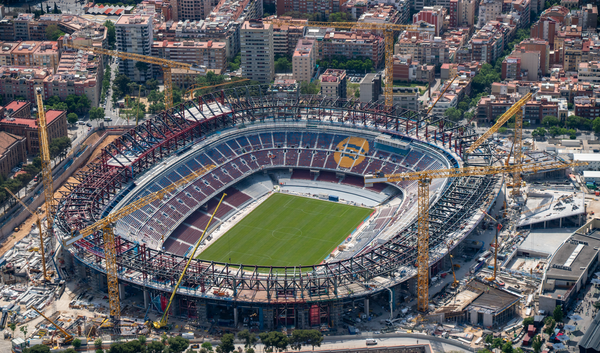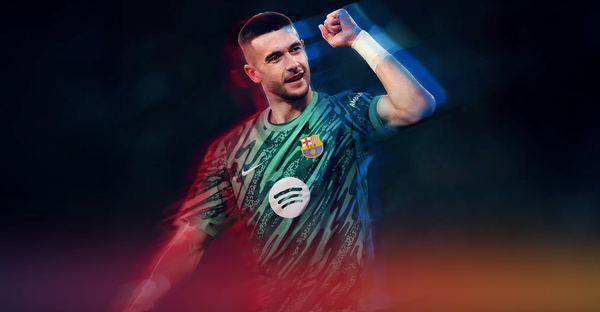Ferran Torres and the art of elite movement

Ferran Torres. Photo - Shutterstock. Photographer - Christian Bertrand
Some things in football are very difficult to quantify. For example, how does one properly assess the importance of a morale boost? Or how do you use data to show the true value of negative passing? Often, there are things happening in the background many don’t notice that ultimately make the highlight reels possible in the first place. Perhaps it’s the pass backwards that forced the defensive block to shift, creating separation between the lines and thus, creating space. Perhaps it was the manager’s team talk that inspired the players to break their limits. Or maybe, it was the midfield’s dirty work that unleashed the flamboyant difference-maker on the wing.
All of these things are essential aspects of top-performing teams and yet, they are so often overlooked. ‘Statistics are just a pattern of information that we have. There are players who make the team play good without the statistics.’ Pep Guardiola noted recently in a press conference ahead of Manchester City’s FA Cup game against Peterborough United. ‘If you perform to your maximum [level], if you perform to your best and you helped your team-mates and make the process better, it is enough.’ Pep, of course, knows the value of such players because he too was that player. In fact, many pivots tend to be. Sergio Busquets is the same; he’s a cut above the rest but not necessarily flashy. You can make comps of his incredible passes but they are just the icing of the cake that is his unique player profile. Frenkie de Jong is another example - he’s incredibly powerful and an outstanding technician at the same time. But a lot of great work he does goes unnoticed still.
The same can be said for forwards as well. Barcelona’s big January signing, Ferran Torres, is very similar too. Attackers are by and large analysed by the goals they (don’t) score. The same is true for the ex-Valencia man. But have you ever thought how is it that he gets into so many goal-scoring opportunities in the first place? Or how is it that when he’s on the pitch, Barcelona create and exploit space much better? Probably not.
So today, we’ll analyse the unsung hero of many Catalan triumphs and see what’s the secret behind Torres’ elite movement.
Movement of strikers explained
Before we go into Ferran specifically, I want to touch upon movement in a more general sense. Nowadays, modern strikers move in a variety of ways. Harry Kane, for example, moves differently from Robert Lewandowski but both use movement as a key part of their elite tool kit. Kane turns into a deep-lying playmaker despite being a centre-forward, dropping to create numerical superiorities, linking up play and playmaking from deeper areas. The same is true for Karim Benzema, for example, who is an immense associative presence for Real Madrid and for Paris Saint-Germain’s Lionel Messi, who is an elite finisher with elite combinatory & creative traits.
Lewandowski, however, is more akin to Cristiano Ronaldo or Zlatan Ibrahimović. All three provide their teams with irreplaceable box presence and have perfected the art of poaching. Being in the right place at the right time is so much more complex than what it seems on the outside. These players exploit aspects such as timing, blindside runs and change of direction perfectly and use it as a tool to create and score chances on their own.
Finally, you have the players who do a bit of both. The hottest two commodities on the planet are strikers by nature - Kylian Mbappé and Erling Braut Haaland are potential generational talents and - many believe - will define the next decade of world football. While that is yet to be seen despite their undeniable talent, they are in that conversation for a reason. The PSG superstar, for example, is a master of feints, attacking space and can link up and finish plays in one seemingly simple sequence. His Borussia Dortmund counterpart, however, is far more direct and robust but can be an immense transitional tool as well as a poacher of an elite order.
But at the end of the day, all of these players do the basics almost flawlessly. What defines good movement with strikers? It’s difficult to note all of them but facing the play forward, using the blindside, mastering timing and the art of dismarking are just some of them. Movement inherently ties into positioning as well - staying between the centre-backs optimises your chances because it brings chaos into a well-defined structure; the diffusion of responsibility takes its toll and often, the striker roams free. Then we have the importance of gaining the inside track, being an optimistic striker, delaying or even stalling movement completely, explosiveness and changing directions quickly - all of these things are a part of an elite striker’s repertoire. For a more detailed outlook on different profiles and different movements of elite strikers, I’d recommend reading Scott Martin’s incredible piece, which I’ll link here.
And, as we’ll soon see, many of such things are also in Ferran Torres’ arsenal too. Let’s explore them a bit further.
Associative and utilitarian traits
The first aspects I want to touch upon are all utility based. What I mean by that is the work Ferran does is often unselfish in a sense it enables the system to function without necessarily putting him in the spotlight. This can be as simple as drifting wide or centrally to open a passing lane or dragging markers either way to give a teammate more space to play. But all of these things are key to maintaining a functioning system, especially Xavi’s one because this iteration of Barcelona is all about fluidity and movement in possession.
Take Jordi Alba, for example. We’ve known him as this elite marauding full-back who profited from the departure of Neymar Jr. to become Barcelona’s main outlet on the left. Now, however, he moves and acts in relation to his teammates. And so does Ferran. When he moves inward, it opens the flank for Alba to occupy and it also drags markers to create isolations. But even more importantly, it enables Barcelona to occupy all five vertical channels on the pitch when attacking as Torres drifts into the left half-space.

The play above is halted only by Ronald Araújo’s limitations on the ball. You can see Alba calling for the switch and Ferran also attacking space from the deep - Barcelona have successfully isolated their forwards and they’re making the right moves to exploit the situation. Sadly, the attack doesn’t go in that direction. But this is very basic movement from Ferran and a lot of it often seems that way. Remember that doing this well often makes those things look basic or mundane. But if it was so easy, everyone would do it on a high enough level.
Ferran, however, uses his gravity quite well. He knows what moves will unsettle the block and force pieces to start moving as well. That’s where opening passing channels comes into place. Dropping deeper to drag markers is something modern strikers have to be able to do and recognising when and how to do it is key. Take the following two sequences as a good example.
In the first one, Ferran drops to give Araújo a progressive option but the striker is not always expected to receive the ball in such situations. Notice that he’s attracted a lot of attention to himself and Araújo sending the ball his way does more bad than good. Instead, Barcelona should’ve gone for a different solution.

The space behind the opposition’s back was created through Torres’ movement and it was Nico González who should’ve burst into it. Similarly, a Barcelona centre-back needs to be able to follow up such movements with his passing. Now contrast this with the same happening in the second example where Sergiño Dest and Pedri combine with Ferran.
Dest is the highlighted one in the image and Pedri makes the run from the deep, which is largely expected from Barcelona interiors under Xavi. But it’s Ferran who makes it happen by moving towards the inside and laying the ball off to the American full-back. This movement enables the third-man run and Dest pings the ball over the top in an attempt to find Pedri. Sadly for them, the attack breaks down but the principle remains visible.
This, however, is all closely related to Ferran creating space for others to exploit. But it’s also only a part of his great spatial and positional awareness. The next image shows us something similar but ultimately different.

Here, Ferran steps out of the cover shadow to not only enable progression but also free himself to receive between the lines. This gives him space and time to attack but also allows him to reposition himself so that he faces the play forward and can run with the ball. Receiving in those areas with a forward-facing body orientation is how one moves off the ball with minimal contact to influence the play in a positive way. In Ferran’s case, his movement gave him time to reposition and despite not receiving the ball in forward-facing body orientation, he still adjusted accordingly to reap the benefits of it.
This isn’t an isolated case either - the young forward does it very often and it comes as a result of both his great movement and technical quality. When playing as a Barcelona striker, engaging in link-ups and combinations from the deep is inevitable. Fortunately for both parties, Ferran is good at associative football. Apart from knowing when to drop to receive and when to drop to disrupt the opposition’s structure, he is also capable of controlling the ball should he attain possession.
In the image below, you can see him receiving and perfectly controlling a long ball.
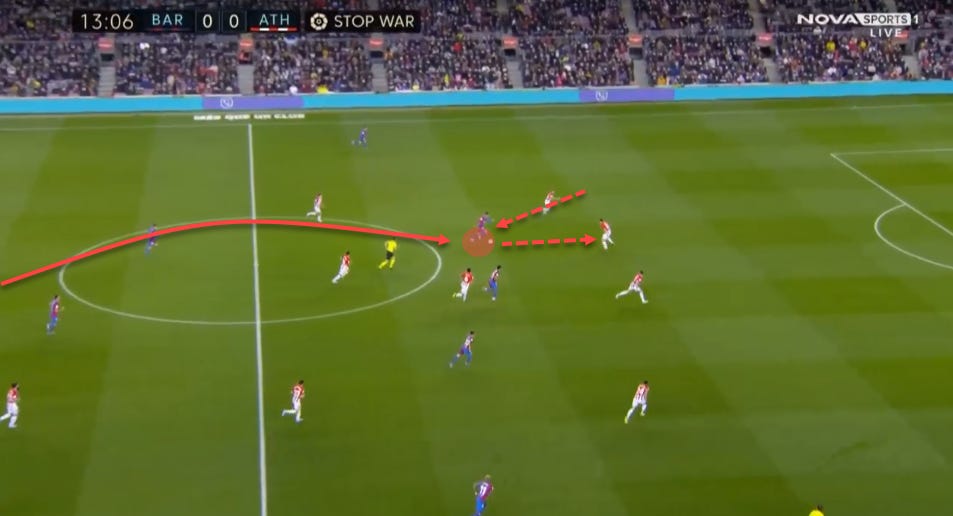
Again, he finds himself in acres of space because the defenders are afraid to commit any further. This is reasonable because Barcelona have outlets charging into the space left behind their backs. Ferran himself can do it too because of his forward-facing orientation without the added pressure of the defensive line. He offered a long-distance solution to bypass the press, controlled it perfectly and made use of the decisional crisis placed upon the backline to reposition himself optimally to continue the attack. Seems simple. In reality, however, it’s far from it.
The final example I’d like to discuss in this section is creating separation by switching directions quickly. Ferran is incredibly agile and can perform moves akin to players with a low centre of gravity. The ability to wrong-foot the defender can be invaluable both inside the box and deeper on the pitch. After rewatching El Clásico, I couldn’t help but marvel at how he’d constantly gotten the better of his markers just by repeating that single move.
So here’s Ferran creating separation against Real Madrid, a story in four pictures.
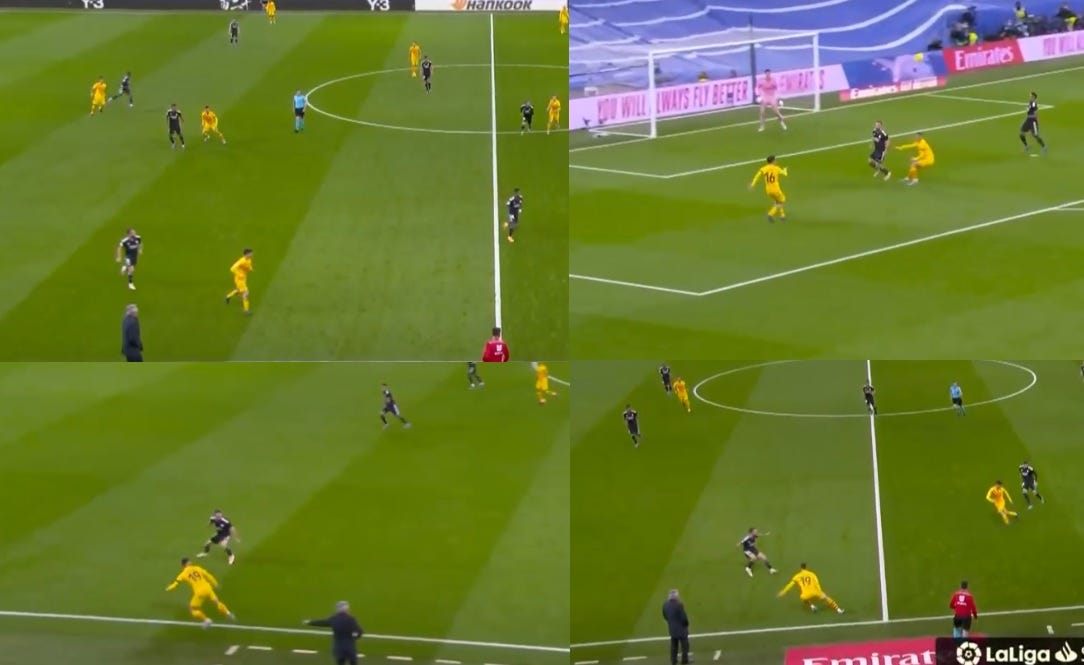
These are far from the only examples, mind you. But they are some I liked best. Ferran likes to move in one direction and then explode into the other almost seamlessly. The defenders, needless to say, often have trouble keeping up. This is also how you both create and exploit space. Often, it can result in high-quality chances for Barcelona, as was the case many times already.
Chance-creation & poaching
Now we come to the more exciting part of Ferran’s movement analysis. So far, according to Wyscout, the young forward has scored six goals and assisted four in 1185 minutes since his arrival in January, accumulating 5.72 xG. This does indicate that he’s more or less scoring at the rate he should be, contrary to the popular belief. Yes, he can miss an odd big chance but it’s often due to his own efforts that he finds himself in those chances in the first place.
Before we move on to examples of his movement, let’s firstly explore the shotmap of his last 75 attempts, excluding penalty kicks. There is one critical thing to take out of it - shot locations.
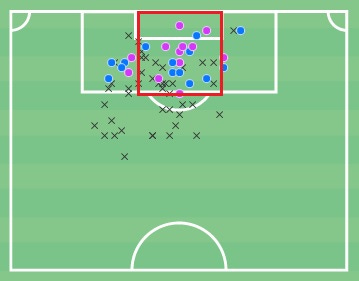
Note that most of his goals (purple) and on target attempts (blue) come from central zones that optimise goal-scoring chances. In other words, those are generally positions that yield high xG or high goal-scoring probability values. Good strikers are often in the right place at the right time but there is so much more to that than luck. Movement, for one, is a key aspect of the equation.
It’s because of that movement that Ferran’s profile is absolutely essential for Xavi’s system. When you narrow it down to a single facet, recognising and attacking space is the most basic and yet the most fundamental trait he possesses. We’ve seen it in action so many times already too.
Take this example against Real Madrid. Pierre Emerick Aubameyang has drifted toward the left, dragging the marker and Pedri has done the same from a more central midfield position. Los Blancos are trying to collapse but in the process, they leave a channel exposed for Ferran to exploit.
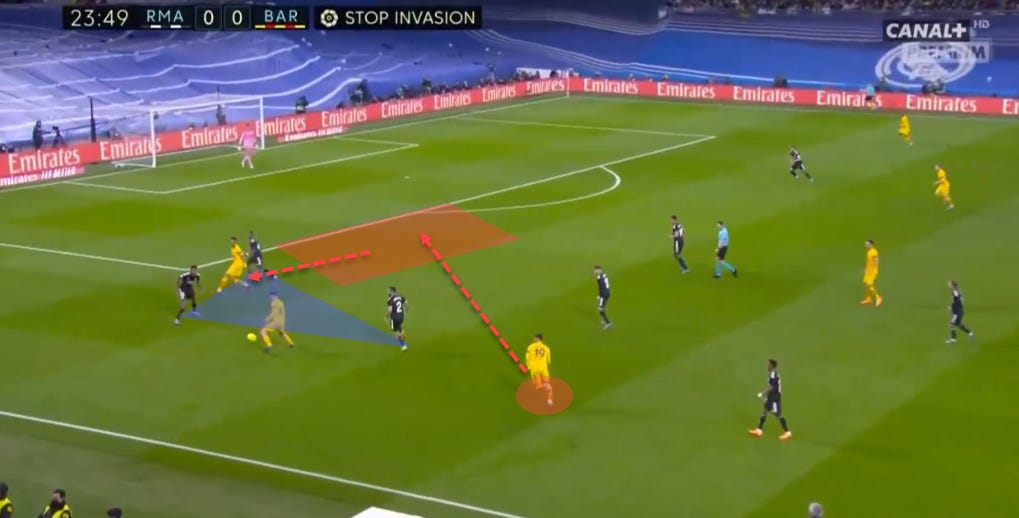
Moments later, Pedri shruggs off his marker and deploys a lofted pass into Torres’ feet, just around the entrance to the box. This, of course, is a team move. Without Aubameyang’s movement and Pedri’s touch, Ferran doesn’t get into a good position to shoot but not all players would recognise or make that darting run through the half-space. Fortunately, it’s in Torres’ nature to do so and do so consistently.
Let’s explore a couple more examples of him identifying the space and then attempting to exploit it to get into a good scoring situation. Below, you can see something that reminds me of how Mbappé or Kane operate. Both players tend to start and finish sequences, often following through with their run after initially linking up with their teammates.
We find Ferran starting out wide on the left before combining with Busquets down the middle but then continuing his run to exploit the space behind the opposition’s line.

Once again it’s the simple aspect of just seeing where the space has opened up and then attacking it relentlessly. Unfortunately, the pass from Dani Alves doesn’t connect but the intent and the blueprint are clearly shown nonetheless. Another thing to note is how Ferran plays off of Aubameyang’s movement again too. It’s the former Arsenal man whose movement should also be commended as he occupies and pins down the centre-backs, allowing more space for his teammate.
Our next GIF will show us another great example, this time from the game against Elche. Here, we find Ferran and Memphis Depay interchanging positions as Barcelona recycle possession and look for progressive options. Torres drops deeper and Memphis pushes up with a curved run. This disorganises the defence but also shows us one of the main aspects of Torres’ profile.
Often, he will drop deep and then burst back forward, staying on the blindside of the defender and using a sharp turn of pace to explode past them.
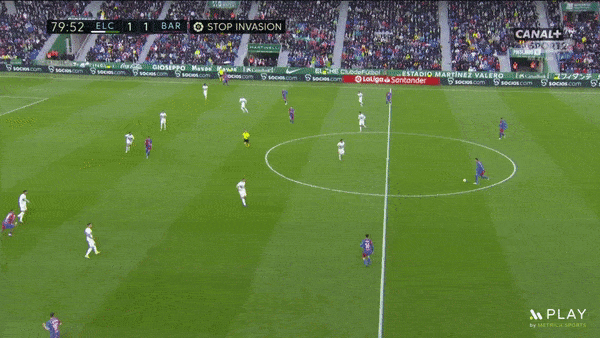
Notice how he’ll jog back to his position while staying on the blindside of the defender, ensuring he’s not in his field of vision. The duo make one final rotation as Memphis drops, dragging the marker and creating space, and Ferran immediately identifies and exploits it. Alba, of course, sends an excellent pass right into his feet.
It’s very interesting to analyse this tendency to slowly creep behind defenders, staying on their blindside without them even noticing he’s closing in. The same happened against Real Madrid too. This almost relaxed demeanor makes the defenders relax too. Only it’s a false sense of security.
What actually happens is Ferran exploits the blindside to create separation. Then, he’s free to receive the ball while having both the time and the space to conjure his next move. And of course, Xavi’s setup is all about creating isolations for their most dangerous pieces of the jigsaw.

But let’s get back to that Elche game because I could’ve easily made a compilation of Ferran’s incredible movement just from that single game and I would’ve easily been able to write the whole piece just based on that. The exchange with Memphis, in particular, is what really stood out. The duo were extremely fluid off the ball, interchanging positions and disorganising the defence at all times.
It’s Gerard Piqué who finds Memphis with a great ball from the deep and the latter’s movement attracts the defender, prompting him to jump out and abandon his position. This, of course, has a side-effect too. As a result of his actions, space had appeared behind his back; it’s the space Ferran will exploit just moments later.
The Dutchman somehow manages to get the ball to the young Spaniard, whose great first touch controls it and sets him up for a run into the penalty area.
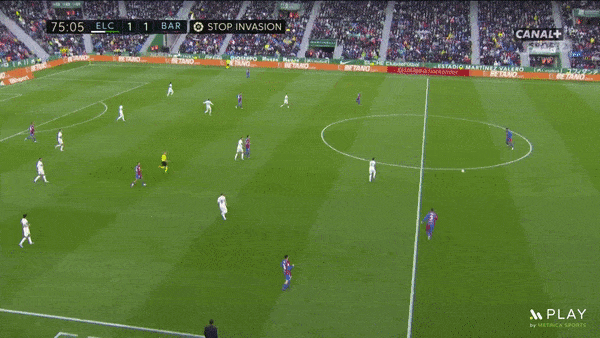
In all fairness, this example is eerily similar to the one we had before, also coming from the Elche game no less. But it’s only because the Memphis-Ferran partnership works that way. The same as Aubameyang and Ferran also create a unique dynamic where one opens space for the other. But similarly to the previous example, Barcelona don’t get their goal from a beautiful sequence due to the finishing touches missing from their forward.
However, without his awareness and movement, there’s no chance in the first place. One other aspect that’s crucial when it comes to elite strikers’ movement is creating separation. And Ferran does it excellently, as we’ve already seen in the previous section of this article. The following sequence, however, is one I enjoyed a lot.
The main thing to note there is how Ferran moves in the opposite direction of the ball and thus, in the opposite direction to all the defenders marking him at the moment.
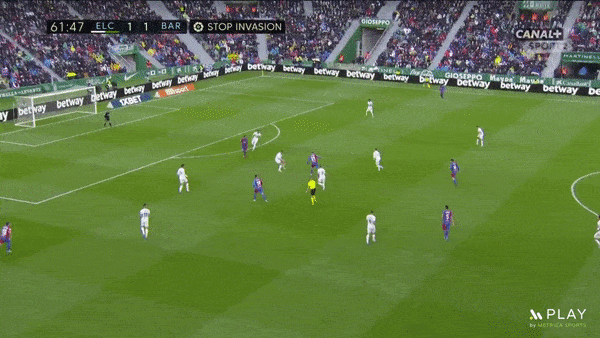
It’s Pedri who dinks the ball over the top to Alba but notice how Ferran moves towards it rather than attempting to attack the same space as his left-back. This results in him in acres of space once Alba finds him on the cutback. Of course, it goes without saying that he should at least hit the target in such a position but the initial movement to create the separation was incredible.
The final example I want to show you will have multiple aspects in one: separation, blindside exploitation, recognising space, turn of pace and gaining the inside track on defenders. This, needless to say, is an incredible package of skills to have and Ferran has them all.
Notice how first, he takes a few steps away from the defender to create the initial separation. Next, he slowly runs back forward, jogging so not to get noticed and positions himself in the defender’s blindside. Now that the marker is not fully aware of Torres’ whereabouts, he explodes in a turn of pace and gains the inside track to give himself the maximum chance of getting to the cross first.
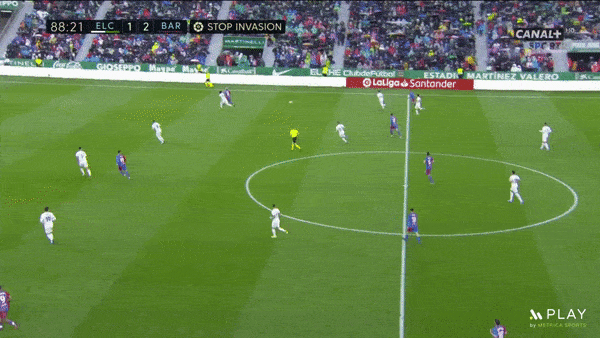
A couple of words on the importance of gaining the inside track on defenders. Generally speaking, the very best players often utilise this tactic because by beating the defender to the inside, you minimise the chance they’ll get to the ball first and clear it. Naturally, attackers can still win the duel by going to the outside but that’s nominally only the option if there’s enough space to exploit. In our example above, Ferran chooses to go to the inside and only slightly mistimes the jump so he doesn’t get the ball.
Timing is another crucial aspect we have to touch upon. Elements such as awareness, decision-making and timing, all of which are interconnected, are very difficult to train. It can be done, of course, and elite strikers or just footballers in general have all three in their arsenal. To successfully time your run is to know your limits, both athletic and technical. How long does it take me to cover that much ground? Can I control the ball even if I get in contact with it? How powerful is my jump? All of that needs to be taken into consideration and a slight miscalculation, as seen in the above example too, can mean the difference between a missed opportunity and a goal scored.
Nonetheless, what Ferran has shown so far is nothing short of impressive.
Final remarks
At 22 years of age, Ferran Torres still has a long way to go in terms of his development. But contrary to popular belief, he’s an incredible utility player who will only get better as he progresses through his career. The Spaniard’s movement, in particular, is key to Barcelona’s chance-creation and key to maintaining the elite structure Xavi has assembled in Catalonia.
Once his confidence goes up and he adjusts his scoring boots, Ferran will start bagging goals at a much, much higher rate. He may not seem like the player to lead the project but he’s still an invaluable piece of the puzzle that’s bound to become even more important.
Here’s to his future at Barcelona.

